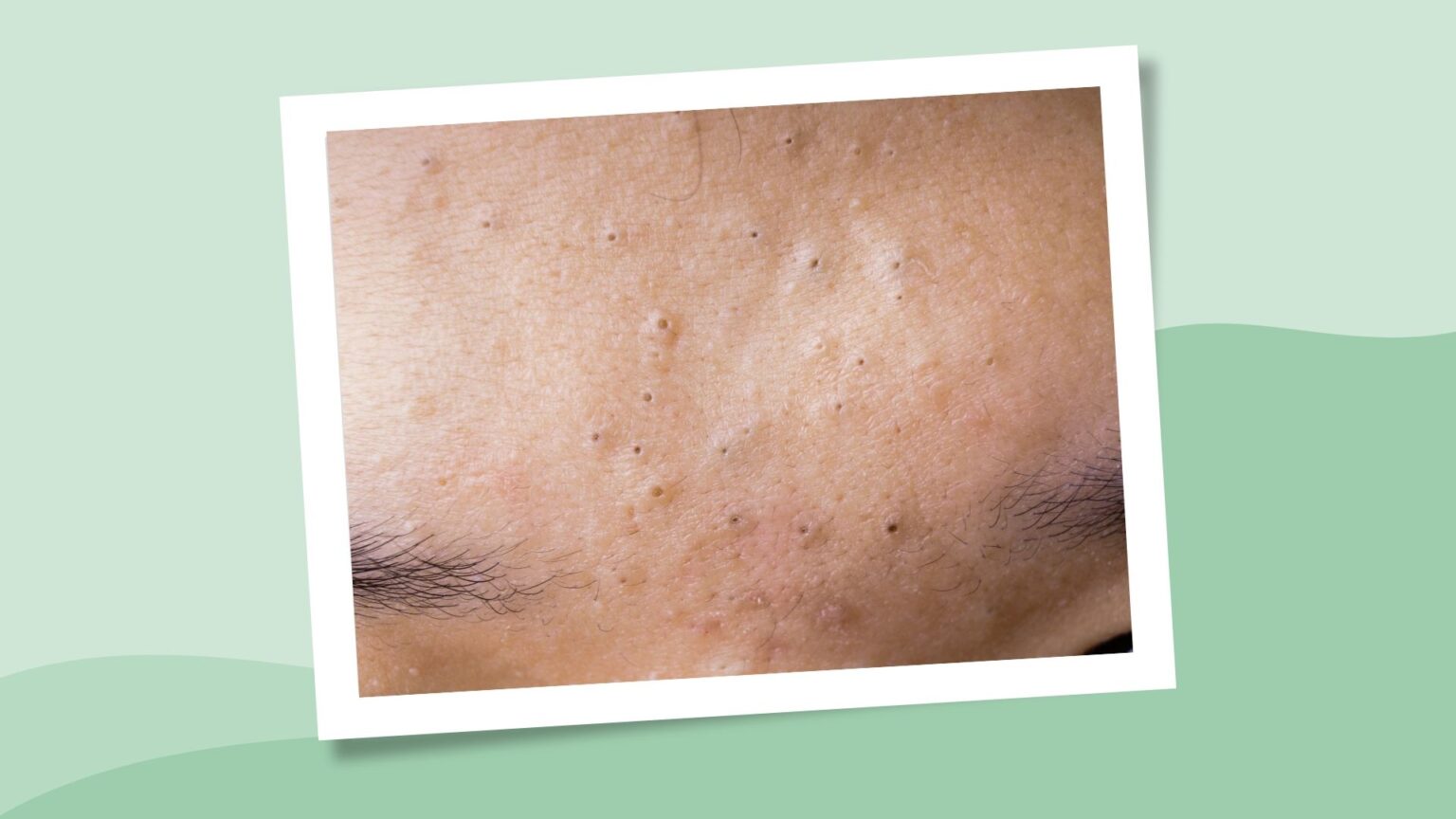Comedones are a type of acne that occurs when hair follicles in the skin become clogged by oil, dead skin cells, and debris. This causes small bumps commonly known as blackheads (open comedones) or whiteheads (closed comedones) to form.e60dc2a1-f33c-4a05-9b50-8e3e8e597629bb31d02e-b146-4512-9450-b09e10c0445c Comedones look like small, flesh-colored, white or dark bumps on the skin with a solid core in the middle of the bump.e60dc2a1-f33c-4a05-9b50-8e3e8e597629bcd180d0-32aa-4cfc-8b93-99079772269d Comedones can be a precursor to worse acne breakouts and may need treatment. Comedones can be managed with over-the-counter or prescription medications, a regular skin-care routine, and healthy lifestyle changes.
Types of Comedones Types Think of comedones as the mildest form of acne — they haven’t developed into pus-filled pimples, but they’re clogged pores that create bumps in the skin.e60dc2a1-f33c-4a05-9b50-8e3e8e59762952f8572a-d028-4253-a153-d80e274de427 As mentioned, comedones fall into two main categories: Closed Comedones Closed comedones, more commonly known as whiteheads, are closed bumps on the skin that look white or yellowish.e60dc2a1-f33c-4a05-9b50-8e3e8e5976290ef61c7d-a2f3-40ec-8e76-cc0d739522aa They are small cysts filled with excess oil and dead skin cells that trap hair within the follicle.e60dc2a1-f33c-4a05-9b50-8e3e8e5976297a5f95d7-848c-4b08-8330-c5fffadc39fe Open Comedones Also known as blackheads, these are open bumps filled with excess sebum and dead skin cells. It may look like dirt is in the bump, hence their name, but the dark color is caused by oxidized lipids (oily substances) and melanin. Open comedones don’t hurt or feel uncomfortable to touch the way whiteheads can.e60dc2a1-f33c-4a05-9b50-8e3e8e597629d648377b-b8c4-4e31-acf1-91e5921f0be4e60dc2a1-f33c-4a05-9b50-8e3e8e597629a667d131-2d23-40a0-99e2-9fc9f809d134e60dc2a1-f33c-4a05-9b50-8e3e8e597629da1c5ded-b187-4084-8435-59b2d7e68f7b Both types of comedones appear on the face — especially the forehead, chin, and nose — and may also be present on the neck, back, or chest. Blackheads typically form on the sides and bridge of the nose. There are other types of comedones, too, including:e60dc2a1-f33c-4a05-9b50-8e3e8e597629e579a33e-d450-4b90-b92b-fa2b09551693 Sandpaper Comedones Multiple small, closed bumps on the forehead are called sandpaper comedones. This type of comedone gets its name from the feel and look of the affected skin. Microcomedones These are tiny clogged pores and are not visible to the naked eye. This is an early stage before they become visible bumps on the skin. Macrocomedones These are the opposite of microcomedones — they’re larger, measuring greater than 1 millimeter (mm) in diameter, and can be easily spotted. If comedones of this size are whiteheads, they may not be easily treated by topical and oral ointments. Submarine, or Missed, Comedones These are deep-seated comedones that are greater than 5 mm in size and can lead to inflamed pimples as the clogged pore worsens. They’re often missed because they’re sitting under the skin and are not obvious. Secondary Comedones These are clogged pores triggered by hair pomade, oils not from the skin, or chemical exposure such as smoking . Solar Comedones Also known as Favre-Racouchot syndrome, solar comedones are blackheads, whiteheads, and skin cysts on the face that have been triggered by sun damage. They tend to appear later in life, and typically affect people who have had prolonged sun exposure over their lifetime. It can also come from heavy cigarette smoking.e60dc2a1-f33c-4a05-9b50-8e3e8e59762906eebec3-32de-4c0e-9c27-b651ca872c05
Signs and Symptoms of Comedones Symptoms You can usually identify comedones by closely examining your skin. Common signs and symptoms include:e60dc2a1-f33c-4a05-9b50-8e3e8e59762946e46bdc-87c1-4103-b196-1799a441d384 Small bumps on the face, neck, chest, or back Black or white spots, depending on whether the pore is open or closed Mild skin texture irregularities They may not be painful but can become inflamed if bacteria lead to acne breakouts. Blackheads — or closed comedones — don’t cause any physical symptoms, but you’ll see a small bump with what looks like black dirt in it.e60dc2a1-f33c-4a05-9b50-8e3e8e5976292c46057a-7a1e-43c4-b6db-8d3ba5072cda Whiteheads, on the other hand, may be white or yellowish and may be slightly tender to touch.e60dc2a1-f33c-4a05-9b50-8e3e8e59762974405ce2-50c9-4bef-b366-11dc3e416050
Causes and Risk Factors of Comedones Causes Whiteheads and blackheads can pop up in many parts of the body, especially where there may be excess oil production to clog pores. Causes of comedonal acne — and things that may make it worse — include:e60dc2a1-f33c-4a05-9b50-8e3e8e5976299955a83c-0143-4c98-82d6-80cf691b83a5e60dc2a1-f33c-4a05-9b50-8e3e8e597629bd8ef615-2fe0-4bb7-9884-243f9afc9550 Hormonal Changes In certain life stages, such as puberty , you may see a rise in hormonal changes that trigger excess oil production on the skin, leading to more blackheads or whiteheads. Oily Skin People with oily skin may be more likely to have comedonal acne due to excess sebum production.e60dc2a1-f33c-4a05-9b50-8e3e8e5976292bde31cd-55e3-40b6-a8c2-55b47ba90d9f Diet Research has shown a correlation between a diet high in processed carbohydrates like bagels, breads, and chips and worsening acne. Medication Certain drugs, such as corticosteroids or testosterone, may cause new or worsening acne. Stress While stress doesn’t necessarily cause acne, it can make it worse.
How Are Comedones Diagnosed? Diagnosis There are no specific medical tests required for diagnosing comedones. Rather, a dermatologist can diagnose comedones through a visual examination of the skin. Because whiteheads and blackheads are easy to spot, you may not need a healthcare professional to diagnose the condition. But you may choose to see a skin specialist such as a dermatologist if you have severe or persistent acne.e60dc2a1-f33c-4a05-9b50-8e3e8e5976295017d075-0749-4658-a304-cc43c261a156
Treatment and Medication Options for Comedones Treatment Whiteheads and blackheads can be treated at home or in office with a dermatologist, depending on the severity. Medication Options There are plenty of nonprescription medications available at the drugstore that address comedonal acne. They include: Salicylic Acid A popular choice for treating comedones, salicylic acid helps to remove the top layer of damaged skin, gets rid of dead skin cells, and prevents clogged pores.e60dc2a1-f33c-4a05-9b50-8e3e8e5976294fc967d7-eab3-466f-a80b-0e10875f6038 Try to find products that contain about 2 percent to 4 percent salicylic acid. If they’re drying your skin out, decrease the dosage.e60dc2a1-f33c-4a05-9b50-8e3e8e597629deed986d-a83e-43f8-8679-f466ba8b834e Benzoyl Peroxide Also available in various over-the-counter skin care products, including facial cleansers, leave-on gels and ointments, benzoyl peroxide kills surface bacteria, which can trigger acne and aggravate clogged pores. The concentration of benzoyl peroxide within a product usually begins at 2.5 percent, increasing to up to 5 or 10 percent. It can cause initial dryness and some irritation, though your skin should adjust after a week. In rare cases, it can cause a burning sensation, itching or peeling.e60dc2a1-f33c-4a05-9b50-8e3e8e5976293134d162-fa92-47c4-b477-3592c5de0eb1 Azelaic Acid This natural acid found in ingredients, such as barley, wheat and rye, kills bacteria on the skin and reduces swelling. One study that followed real-world cases of women with acne, including comedones, found that azelaic acid — in a 15 percent gel form applied twice daily — played a key role in managing acne and post-acne hyperpigmentation.e60dc2a1-f33c-4a05-9b50-8e3e8e597629fa5f3510-32fa-4b25-a7a1-dd556ba70cf5e60dc2a1-f33c-4a05-9b50-8e3e8e5976290183f451-0762-4b9f-9506-636fe93c2ac0 Retinoids (Vitamin A Derivatives ) The American Academy of Dermatology recommends retinoids for treating comedones.e60dc2a1-f33c-4a05-9b50-8e3e8e5976298e1f9d4b-4c55-4a7f-92ab-4d25d9b07e7c Over-the-counter products with retinoids help to unclog pores.e60dc2a1-f33c-4a05-9b50-8e3e8e597629d44046eb-dbff-4a45-a26d-b949a6fca94d Researchers say they’re effective in exfoliating comedones, increasing skin cell production, and promoting cell turnover on the skin. It’s a potent compound, so be sure to talk to your medical provider about how much to use and when.e60dc2a1-f33c-4a05-9b50-8e3e8e597629c9e3c8e3-d1bc-4a1c-bb38-22b7516be79b If over-the-counter options aren’t helping, consider seeing a dermatologist who can prescribe medication, such as: Prescription-Grade Retinoids These are stronger topical products than their over-the-counter counterparts, and require a prescription to pick up. They include adapalene (Differin, Epiduo), alitretinoin (Penretin), bexarotene (Targretin), tazarotene (Tazorac, Avage), and tretinoin (Atralin, Avita, Retin-A, and Tretin-X). Like all retinoids, the prescription-strength kind also helps to unclog pores, remove dead skin cells, and encourage cell turnover. Your skin may go through a “retinol purge” and look worse in the first couple of months of treatment before it starts to look better.e60dc2a1-f33c-4a05-9b50-8e3e8e597629077544bc-3706-477c-957e-e59654623188 Oral Antibiotics In moderate to severe cases of acne, your dermatologist may prescribe oral antibiotics , such as clindamycin or erythromycin, to reduce bacteria on the skin. They’re often prescribed in combination with other treatments, such as benzoyl peroxide.e60dc2a1-f33c-4a05-9b50-8e3e8e597629ee2f4210-99fc-40bd-863e-550a56aa9f90
Complementary and Integrative Therapies Your doctor or dermatologist may recommend complementary and integrative therapies to treat comedones. Note that not all of these in-office procedures are covered by insurance. Chemical Peels A chemical peel involves applying a chemical solution to your skin, which causes skin layers to eventually peel off, revealing more youthful skin. It’s used to treat acne and smoothen the texture of the skin.e60dc2a1-f33c-4a05-9b50-8e3e8e59762977f41c33-3b13-41de-9626-6dd7d8b047d8 Extractions Dermatologists or medical aestheticians can perform a manual extraction of blackheads and whiteheads. For this procedure, your skin will be prepped with a light steam to expand your pores. Then, they’ll use a sterilized metal tool called a comedone extractor to apply pressure until all the contents of the bump have been removed. Don’t try to extract comedones at home because it may lead to scarring.e60dc2a1-f33c-4a05-9b50-8e3e8e59762955a17a5c-6723-4131-8e58-b3135555c6b7 Research suggests extraction is a simple and effective remedy, especially for treating moderate acne, including comedones.e60dc2a1-f33c-4a05-9b50-8e3e8e597629d488c806-aee3-4dfa-a841-7c2391978541 Microdermabrasion In this procedure, a professional uses a specialized tool to gently “sand” the top layer of your skin, removing the buildup that causes whiteheads.e60dc2a1-f33c-4a05-9b50-8e3e8e5976291c6de215-cfa0-47b4-96e2-f1667633b3ad Laser Skin Resurfacing In this procedure, short, concentrated, pulsating beams of light are aimed at your skin to target comedones, specifically whiteheads. The light beams aid in reducing oil production to prevent clogged pores.e60dc2a1-f33c-4a05-9b50-8e3e8e597629915fd13c-bbb0-4bac-b3ed-c818906a3e0d
Prevention of Comedones Prevention Small lifestyle changes may prevent comedones from forming. These can include:e60dc2a1-f33c-4a05-9b50-8e3e8e5976299b267ada-c830-4f22-8c18-ea2cd5aea5df Wash your face regularly using warm water and a mild cleanser. Use a moisturizer . Opt for noncomedogenic makeup products that allow the skin to breathe. Remove makeup at the end of each day to help prevent clogged pores. Keep your hands away from your face.
Comedones Prognosis Prognosis and Outlook Comedones are very treatable. They can usually be managed with over-the-counter or prescription cleansers, gels, and ointments. A dermatologist can support you in managing comedonal acne and achieving clearer skin.e60dc2a1-f33c-4a05-9b50-8e3e8e5976295db242f3-8c27-4a43-be06-6de825b69187
Complications of Comedones Complications As mentioned, comedones can progress to worsened acne if they’re not properly managed and treated. Other potential complications of acne include:e60dc2a1-f33c-4a05-9b50-8e3e8e5976292fa618ef-fa7b-41d1-a945-88bce125a037 Acne scarring Stress Anxiety Depression
Research and Statistics: Who Has Comedones? Research and Statistics Blackheads and whiteheads are very common, especially in certain life stages like the teenage years.e60dc2a1-f33c-4a05-9b50-8e3e8e59762984b636b6-2c5c-4014-a10c-179ea1792ec9 Researchers say acne, including comedones, is the eighth most common skin disease in the world, with an estimated worldwide prevalence of 9.38 percent across all ages. Anywhere between 35 percent to nearly 100 percent of adolescents have had acne at some point, although this varies by country.e60dc2a1-f33c-4a05-9b50-8e3e8e59762973767e7d-3f30-45f0-92f3-0dde98e7cf80 It can start as early as age 7 to 12 and typically improves once someone reaches their twenties, but it can persist into adulthood or occur for the first time in adulthood for some people.e60dc2a1-f33c-4a05-9b50-8e3e8e5976297789e890-c703-4012-8041-0e281d1d776f Research has also suggested that some racial and ethnic groups encounter more severe acne than others. People of Asian and African descent are more likely to have severe forms of acne, whereas mild acne is more common in the white population. Overall, people with darker skin tones are more likely to develop hyperpigmentation after an acne breakout than people with lighter skin tones.e60dc2a1-f33c-4a05-9b50-8e3e8e597629e074341f-aae4-45d9-84ab-90444e5930a3
The Takeaway Comedones — more commonly known as blackheads and whiteheads — are a type of acne that occurs when pores become clogged with oil, dead skin cells, and debris, forming small bumps on the skin. Blackheads (open comedones) have a small black tip, while whiteheads (closed comedones) look like small, flesh-colored bumps. Comedones can be managed with over-the-counter or prescription products, in-office procedures, and lifestyle changes.
Resources We Trust Cleveland Clinic: BlackheadsCleveland Clinic: WhiteheadsMayo Clinic: Acne: Diagnosis & TreatmentMedlinePlus: ComedonesAmerican Academy of Dermatology: How to Treat Different Types of Acne
Read the full article here
Leave a comment




